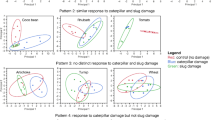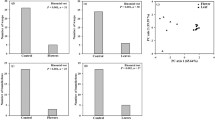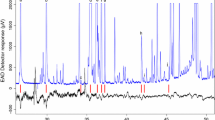Abstract
Plants that are damaged by herbivores emit complex blends of volatile compounds that often cause neighboring branches to induce resistance. Experimentally clipped sagebrush foliage emits volatiles that neighboring individuals recognize and respond to. These volatiles vary among individuals within a population. Two distinct types are most common with either thujone or camphor as the predominate compound, along with other less common types. Individuals respond more effectively to cues from the same type, suggesting that some of the informative message is contained in the compounds that differentiate the types. In this study, we characterized the chemical profiles of the two common types, and we examined differences in their microhabitats, morphologies, and incidence of attack by herbivores and pathogens. Analysis by gas chromatography coupled with mass spectrometry revealed that the camphor type had higher emissions of camphor, camphene, and tricyclene, while the thujone type emitted more α-thujone, β-thujone, (Z)-salvene, (E)-salvene, carvacrol, and various derivatives of sabinene. We were unable to detect any consistent morphological or microhabitat differences associated with the common types. However, plants of the thujone type had consistently higher rates of damage by chewing herbivores. One galling midge species was more common on thujone plants, while a second midge species was more likely to gall plants of the camphor type. The diversity of preferences of attackers may help to maintain the variation in volatile profiles. These chemical compounds that differentiate the types are likely to be informative cues and deserve further attention.





Similar content being viewed by others
References
Agrawal AA, Colfer RG (2000) Consequences of thrips-infested plants for attraction of conspecifics and parasitoids. Ecol Ent 25:493–496
Alborn HT, Turlings TCJ, Jones TH, Stenhagen G, Loughrin JH, Tumlinson JH (1997) An elicitor of plant volatiles from beet armyworm oral secretion. Science 276:945–949
Amiot J, Salmon Y, Collin C, Thompson JD (2005) Differential resistance to freezing and spatial distribution in a chemically polymorphic plant Thymus vulgaris. Ecol Lett 8:370–377
Amo L, Jansen JJ, van Dam NM, Dicke M, Visser ME (2013) Birds exploit herbivore-induced plant volatiles to locate herbivorous prey. Ecol Lett 16:1348–1355
Bidart-Bouzat MG, Kliebenstein DJ (2008) Differential levels of insect herbivory in the field associated with genotypic variation in glucosinolates in Arabidopsis thaliana. J Chem Ecol 34:1026–1037
Davies NW (1990) Gas chromatographic retention indices of monoterpenes and sesquiterpenes on methyl silicone and carbowax 20 M phases. J Chromatogr A 503:1–24
De Moraes CM, Lewis WJ, Pare PW, Tumlinson JH (1998) Herbivore infested plants selectively attract parasitoids. Nature 393:570–574
Deiml T, Haseneder R, Zieglgansberger W, Rammes G, Eisensamer B, Rupprecht R, Hapfelmeier G (2004) Alpha-thujone reduces 5-HT3 receptor activity by an effect on the agonist-induced desensitization. Neuropharmacology 46:192–201
Delphia CM, Rohr JR, Stephenson AG, De Moraes CM, Mescher MC (2009) Effects of genetic variation and inbreeding on volatile production in a field population of horsenettle. Intl. J Plant Sci 170:12–20
DeMoraes CM, Mescher MC, Tumlinson JH (2001) Caterpillar-induced nocturnal plant volatiles repel conspecific females. Nature 410:577–580
Dethier VG (1947) The response of hymenopterous parasites to chemical stimulation of the ovipositor. J Exp Zool 105:199–207
Dicke M (1986) Volatile spider-mite pheromone and host-plant kairomone, involved in spaced-out gregariousness in the spider mite, Tetranychus urticae. Physiol Ent 11:251–262
Dicke M, van Loon JA (2000) Multitrophic effects of herbivore-induced plant volatiles in an evolutionary context. Ent Exp Appl 97:237–249
Drukker B, Scutareanu P, Sabelis MW (1995) Do Anthocorid predators respond to synomones from Psylla-infested pear trees under field conditions? Ent Exp Appl 77:193–203
Dudareva N, Pichersky E, Gershenzon J (2004) Biochemistry of plant volatiles. Plant Physiol 135:1893–1902
Dudareva N, Negre F, Nagegowda DA, Orlova I (2006) Plant volatiles: recent advances and future prospects. Crit Rev Plant Sci 25:417–440
Egerton-Warburton LM, Ghisalberti EL, Considine JA (1998) Intraspecific variability in the volatile leaf oils of Chamelaucium uncinatum (Myrtaceae). Biochem Syst Ecol 26:873–888
Foster AJ, Hall DE, Mortimer L, Abercromby S, Gries R, Gries G, Bohlmann J, Russell J, Mattsson J (2013) Identification of genes in Thuja plicata foliar terpenoid defenses. Plant Physiol 161:1993–2004
Fournier DA, Skaug HJ, Ancheta J, Ianelli J, Magnusson A, Maunder M, Nielsen A, Sibert J (2012) AD model builder: Using automatic differentiation for statistical inference of highly parameterized complex nonlinear models. Optimization Models and Software 27:233–249
Frost CJ, Mescher MC, Dervinis C, Davis JM, Carlson JE, De Moraes CM (2008) Priming defense genes and metabolites in hybrid poplar by the green leaf volatile cis-3-hexenyl acetate. New Phytol 180:722–734
Gotelli NJ, Ellison GN (2004) A primer of ecological statistics. Sinauer, Sunderland MA
Gouinguene S, Degen T, Turlings TCJ (2011) Variability in herbivore-induced odour emissions among maize cultivars and their wild ancestors (teosinte. Chemoecology 11:9–16
Gouyon PH, Vernet P, Guillerm JL, Valdeyron G (1986) Polymorphisms and environment – the adaptive value of the oil polymorphisms in Thymus vulgaris L. Heredity 57:59–66
Grausgruber-Groger S, Schmiderer C, Steinborn R, Novak J (2012) Seasonal influence on gene expression of monoterpene synthases in Salvia officinalis (Lamiaceae). J Plant Physiol 169:353–359
Grayer RJ, Kite GC, Goldstone FJ, Bryan SE, Paton A, Putievsky E (1996) Intraspecific taxonomy and essential oil chemotypes in sweet basil, Ocimum basilicum. Phytochemistry 43:1033–1039
Hare JD (2007) Variation in herbivore and methyl jasmonate-induced volatiles among genetic lines of Datura wrightii. J Chem Ecol 33:2028–2043
Hare JD (2011) Ecological role of volatiles produced by plants in response to damage by herbivorous insects. Annu Rev Entomol 56:161–180
Heil M, Silva-Bueno C (2007) Within-plant signaling by volatiles leads to induction and priming of an indirect plant defense in nature. Proc Natl Acad Sci U S A 104:5467–5472
Holopainen M, Hiltunen R, Lokki J, Forsen K, Schantz MV (1987) Model for the genetic control of thujone, sabinene and umbellulone in tansy (Tanacetum vulgare L). Hereditas 106:205–208
Horiuchi J, Arimura G, Ozawa R, Shimoda T, Takabayashi J, Tishioka T (2003) A comparison of the responses of Tetranychus urticae (Acari: Tetranychidae) and Phytoseiulus persimilis (Acari: Phytosdiidae) to volatiles emitted from lima bean leaves with different levels of damage made by T. urticae or Spodoptera exigua (Lepidoptera: Noctuidae). Appl Entomol Zool 38:109–116
Jirovetz L, Buchbauer G, Stoyanova AS, Georgiev EV, Damianova ST (2003) Composition, quality control, and antimicrobial activity of the essential oil of long-time stored dill (Anethum graveolens L.) seeds from Bulgaria. J Agric Food Chem 51:3854–3857
Karban R (2007a) Damage to sagebrush attracts predators but this does not reduce herbivory. Entomol Exp Appl 125:71–80
Karban R (2007b) Experimental clipping of sagebrush inhibits seed germination of neighbors. Ecol Lett 10:791–797
Karban R (2015) Plant sensing and communication. Univ Chicago Press, Chicago
Karban R, Baldwin IT, Baxter KJ, Laue G, Felton GW (2000) Communication between plants: induced resistance in wild tobacco plants following clipping of neighboring sagebrush. Oecologia 125:66–71
Karban R, Shiojiri K, Huntzinger M, McCall AC (2006) Damage-induced resistance in sagebrush: volatiles are key to intra- and interplant communication. Ecology 87:922–930
Karban R, Shiojiri K, Ishizaki S (2010) An air transfer experiment confirms the role of volatile cues in communication between plants. Am Nat 176:381–384
Karban R, Wetzel WC, Shiojiri K, Ishizaki S, Ramirez SR, Blande JD (2014) Deciphering the language of plant communication: volatile chemotypes of sagebrush. New Phytol 204:380–385
Keefover-Ring K, Thompson JD, Linhart YB (2008) Beyond six scents: Defining a seventh Thymus vulgaris chemotype new to southern France by ethanol extraction. Flav Frag J 24:117–122
Kessler A, Baldwin IT (2001) Defensive function of herbivore-induced plant volatile emissions in nature. Science 291:2141–2144
Khan ZR, James DG, Midega CAO, Pickett J (2008) Chemical ecology and conservation biological control. Biol Cont 45:210–214
Kikuta Y, Ueda H, Nakayama K, Katsuda Y, Ozawa R, Takabayashi J, Hatanaka A, Matsuda K (2011) Specific regulation of pyrethrin biosynthesis in Chrysanthemum cinerariaefolium by a blend of volatiles emitted from artificially damaged conspecific plants. Plant Cell Physiol 52:588–596
Linhart YB, Thompson JD (1995) Terpene-based selective herbivory by Helix aspersa (Mollusca) on Thymus vulgaris (Labiatae). Oecologia 102:126–132
Linhart YB, Thompson JD (1999) Thyme is of the essence: biochemical polymorphism and multi-species deterrence. Evol Ecol Res 1:151–171
Linhart YB, Gauthier P, Keefover-Ring K, Thompson JD (2015) Variable phytotoxic effects of Thymus vulgaris (Lamiaceae) terpenes on associated species. Intl J Plant Sci 176:20–30
Lloyd SR, Schoonbeek H, Trick M, Zipfel C, Ridout CJ (2014) Methods to study PAMP-triggered immunity in Brassica species. MPMI 27:286–295
Mäntylä E, Alessio GA, Blande JD, Heijari J, Holopainen JK, Laaksonen T, Piirtola P, Klemola T (2008) From plants to birds: higher avian predation rates in trees responding to insect herbivory. PLoS One 3:–e2832
Mattiacci L, Dicke M, Posthumus MA (1995) Beta-glucosidase – an elicitor of herbivore-induced plant odor that attracts host-searching parasitic wasps. Proc Natl Acad Sci U S A 92:2036–2040
Michaeli S, Fromm H (2015) Closing the loop on the GABA shunt in plants: are GABA metabolism and signaling entwined? Front Plant Sci 6:–419
Mirabella R, Rauwerda H, Struys EA, Jakobs C, Triantaphylides C, Haring MA, Schuurink RC (2008) The Arabidopsis her1 mutant implicates GABA in E-2-hexenal responsiveness. Plant J 53:–19213
Moqrich A, Hwang SW, Earley TJ, Petrus MJ, Murray AN, Spencer KSR, Andahazy M, Story GM, Patapoutian A (2005) Impaired thermosensation in mice lacking TRPV3, a heat and camphor sensor in the skin. Science 307:1468–1472
Mumm R, Dicke M (2010) Variation in natural plant products and the attraction of bodyguards involved in indirect plant defense. Can J Zool 88:628–667
Pallini A, Janssen A, Sabelis MW (1997) Odour-mediated responses of phytophagous mites to conspecifics and heterospecific competitors. Oecologia 110:179–185
Pare PW, Tumlinson JH (1997) De novo biosynthesis of volatiles induced by insect herbivory in cotton plants. Plant Physiol 114:1161–1167
Perez-Alonso MJ, Velasco-Negueruela A, Pala-Paul J, Sanz J (2003) Variations in the essential oil composition of Artemisia pedemontana gathered in Spain: chemotype camphor-1,8-cineole and chemotype davanone. Biochem Syst Ecol 31:77–84
Pichersky E, Gershenzon J (2002) The formation and function of plant volatiles: perfumes for pollinator attraction and defense. Curr Opin Plant Biol 5:237–243
Quintana-Rodriguez E, Morales-Vargas AT, Molina-Torres J, Adame-Alvarez RM, Acosta-Gallegos JA, Heil M (2015) Plant volatiles cause direct, induced and associational resistance in common bean to the fungal pathogen Colletotrichum lindemuthianum. J Ecol 103:250–260
R Development Core Team (2008) R: A language and environment for statistical computing. R Foundation, Vienna, Austria
Ravid U, Putievsky E, Katzir I, Carmeli D, Eshel A, Schenk HP (1992) The essential oils of Artemisia judaica L. Flav Frag J 7:69–72
Rodriguez-Saona CR, Rodriguez-Saona LE, Frost CJ (2009) Herbivore-induced volatiles in the perennial shrub, Vaccinium corymbosum, and their role in inter-branch signaling. J Chem Ecol 35:621–649
Romagni JG, Allen SN, Dayan FE (2000) Allelopathic effects of volatile cineoles on two weedy plant species. J Chem Ecol 26:303–313
Scheiner SM (2001) MANOVA: Multiple response variables and multispecies interactions. In: Scheiner SM, Gurevitch J (eds) Design and analysis of ecological experiments, 2nd edn Oxford Univ Press, New York, pp 99–115.
Schuman MC, Heinzel N, Gaquerel E, Svaros A, Baldwin IT (2009) Polymorphism in jasmonate signaling partially accounts for the variety of volatiles produced by Nicotiana attenuata plants in a native population. New Phytol 183:1134–1148
Shulaev V, Silverman P, Raskin I (1997) Airborne signaling by methyl salicylate in plant pathogen resistance. Nature 385:718–721
Skaug H, Fournier D, Nielsen A, Magnusson A, Bolker B (2012) Generalized linear mixed models using AD model builder. R package version 0.7.2.12.
Takabayashi J, Sabelis MW, Janssen A, Shiojiri K, van Wijk M (2006) Can plants betray the presensce of multiple herbivore species to predators and parasitoids? The role of learning in phytochemical information networks. Ecol Res 21:3–8
Thaler JS (1999) Jasmonate-inducible plant defences cause increased parasitism of herbivores. Nature 399:686–688
Thompson JD, Gauthier P, Amiot J, Ehlers BK, Collin C, Fossat J, Barrios V, Arnaud-Miramont F, Keefover-Ring D, Linhart YB (2007) Ongoing adaptation to Mediterranean climate extremes in a chemically polymorphic plant. Ecol Monogr 77:421–439
Veličković DT, Ristić MS, Milosavljević NP, Karabegović IT, Stojičević SS, Lazić ML (2012) Chemical composition of the essential oils of Salvia austriaca Jacq. and Salvia amplexicaulis Lam. from Serbia. Agro Food Industry Hi-tech 23:7–9
Vernet P, Gouyon PH, Valdeyron G (1986) Genetic control of the oil content in Thymus vulgaris L: a case of polymorphism in a biosynthetic chain. Genetica 69:227–231
Wallaart TE, Pras N, Beckman AC, Quax WJ (2000) Seasonal variation of artemisinin and its biosynthetic precursors in plant of Artemisia annua of different geographical origin: proof for the existence of chemotypes. Planta Med 66:57–62
Wason EL, Agrawal AA, Hunter MD (2013) A genetically-based latitudinal cline in the emission of herbivory-induced plant volatile organic compounds. J Ecol 39:1101–1111
Wu W, Yuan M, Zhang Q, Zhu Y, Yong L, Wang W, Qi Y, Guo D (2011) Chemotype-dependent metabolic response to methyl jasmonate elicitation in Artemisia annua. Planta Med 77:1048–1053
Xu HX, Blair NT, Clapham DE (2005) Camphor activates and strongly desensitizes the transient receptor potential vanilloid subtype 1 channel in a vanilloid-independent mechanism. J Neurosci 25:8924–8937
Yin Q-H, Yan F-X, X-Y Z, WuY-H WX-P, Liao M-C, Deng S-W, Yin L-L, Zhang Y-Z (2012) Anti-proliferative and pro-apoptotic effect of carvacrol on human hepatocellular carcinoma cell line HepG-2. Cytotechnology 64:43–51
Zust T, Heichinger C, Grossniklaus U, Harrington R, Kliebenstein DJ, Turnbull LA (2012) Natural enemies drive geographic variation in plant defenses. Science 338:116–119
Acknowledgments
We thank Mikaela Huntzinger, Hongjun Li, Enrico Pezzola, and Kaori Shiojiri for help in the field. Shree Prasad identified pathogens of sagebrush and Will Wetzel identified some of the herbivores. Tao Li provided advice on the PCA analysis. Wittko Francke and Martin Heil improved the manuscript. The work was conducted in UC Sagehen Experimental Forest and other sites in the Tahoe National Forest, and we thank Jeff Brown and Faerthan Felix for facilitating our research at these sites.
Author information
Authors and Affiliations
Corresponding author
Electronic supplementary material
ESM 1
(DOCX 12 kb)
Rights and permissions
About this article
Cite this article
Karban, R., Grof-Tisza, P. & Blande, J.D. CHEMOTYPIC Variation in Volatiles and Herbivory for Sagebrush. J Chem Ecol 42, 829–840 (2016). https://doi.org/10.1007/s10886-016-0741-8
Received:
Revised:
Accepted:
Published:
Issue Date:
DOI: https://doi.org/10.1007/s10886-016-0741-8




